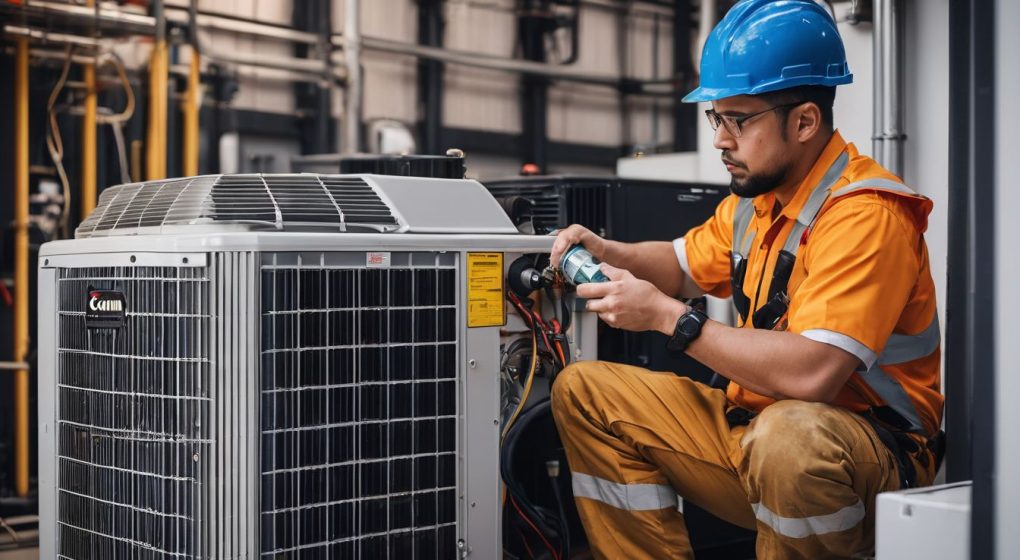
Aircon gas is the secret behind keeping our rooms cool. It changes from a liquid to a gas and back again, taking heat from inside and moving it outside. This special process is called the refrigeration cycle.
Air conditioners use safe gases like R-410A and R-32 because they are better for the environment than old ones like R-22 that harm the air we breathe.
Not just in homes, cars also need this clever system to stay cool on hot days. But if your AC starts smelling odd, pay attention! It could mean there’s a leak or something growing inside that should not be there.
Professionals know how important it is to choose the right aircon gas for your needs and for looking after our planet too. They make sure everything works great without any bad smells.
Keeping things running smoothly means regular checks by experts like Fred Prandecki at Bob’s Repair. Learn how all parts of an AC work together – compressor, condenser, evaporator – so you can enjoy fresh air without worry.
Ready to find out how these cool machines do their job? Let’s go!
The Basic Principle of Aircon Gas

Delve into the heart of your air conditioning system, where a unique substance—known as aircon gas—plays a pivotal role in delivering cool relief from the heat. This crucial component operates on thermodynamic principles to cycle from liquid to vapour and back again, orchestrating the flow of thermal energy for optimal indoor climate control.
How Does an Air Conditioner Work?
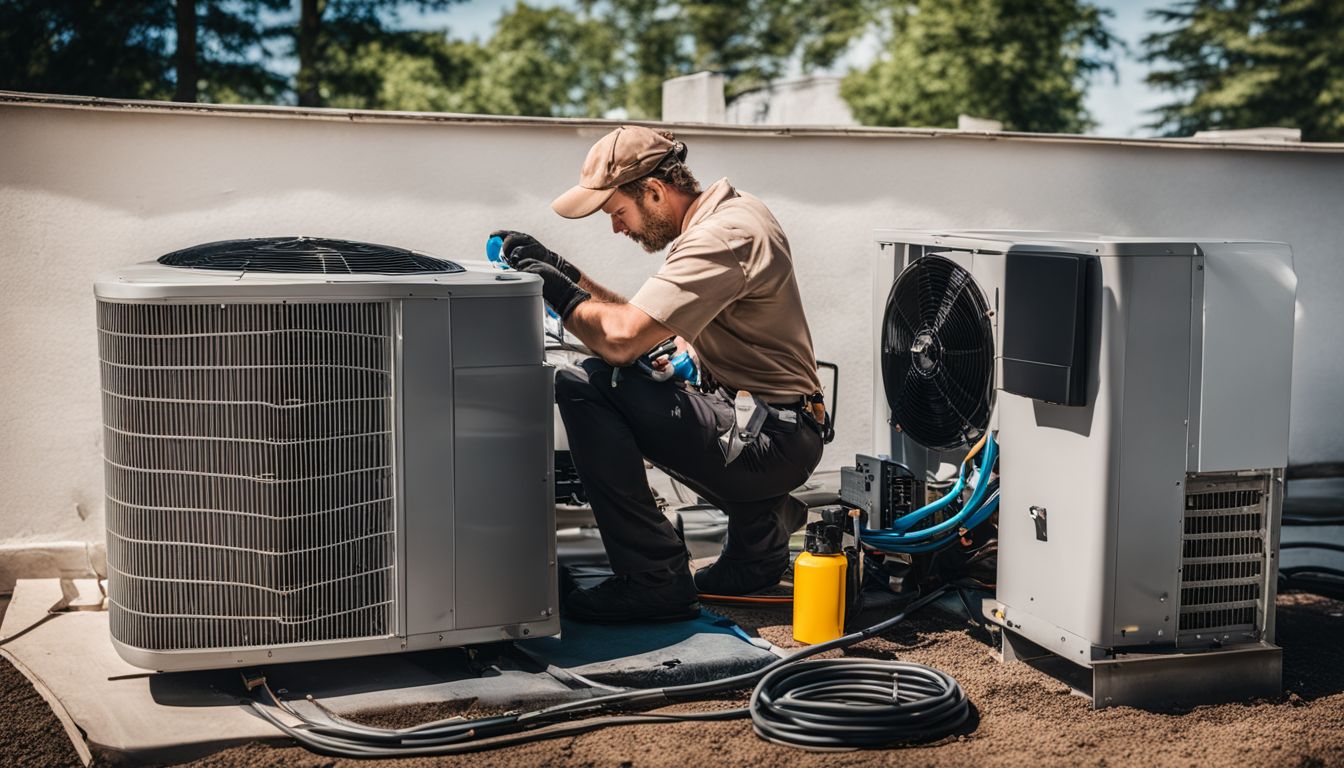
Air conditioners make hot air cool and comfy. Warm room air blows over cold, indoor coils filled with refrigerant. This special liquid absorbs heat from the air and turns into a gas.
As it takes in heat, the refrigerant moves to the compressor.
The compressor squeezes this refrigerant gas, making it hot. Then it goes to the outdoor condenser coils where an outside fan helps blow away the heat. The refrigerant loses its warmth and turns back into a liquid.
Cool again, this liquid is ready to absorb more heat from your home’s air.
The Role of Refrigerant in Air Conditioning

Refrigerant plays a key part in air conditioning systems. It absorbs heat from your room and carries it outside. This keeps your space cool and comfy. The refrigerant changes from liquid to gas and back again as it moves through the system.
These phase changes are crucial for moving heat.
Correct handling of this substance is very important. Refrigerants can hurt our environment if not dealt with properly. They must meet strict rules when being handled or thrown away.
This makes sure we stay safe and look after our planet too.
Understanding the Refrigeration Cycle
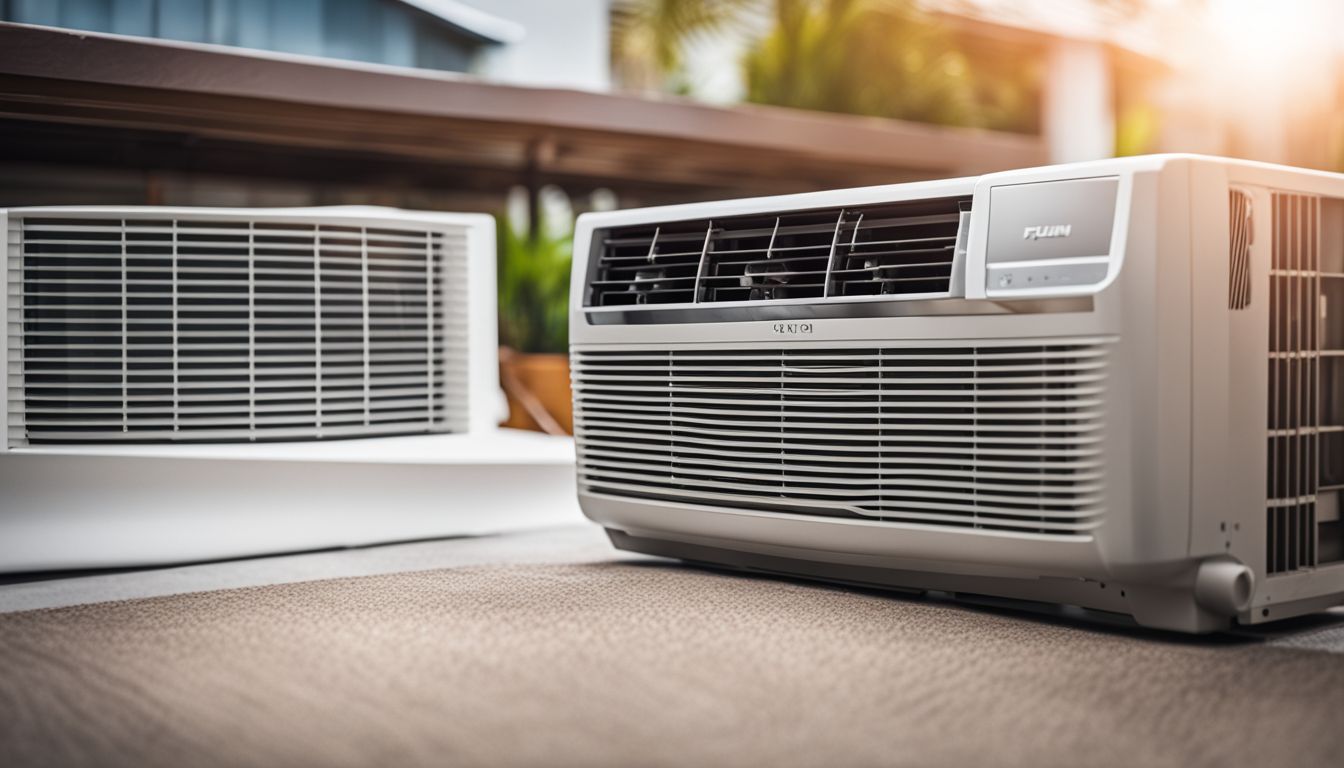
Delve into the heart of your air conditioning unit as we explore the refrigeration cycle, a marvellous loop of physics that keeps indoor spaces blissfully cool. Witness how this essential process harnesses the laws of thermodynamics to transfer heat from inside to outside, creating refreshing havens in our homes and workplaces.
Air Flow Over the Indoor Coils
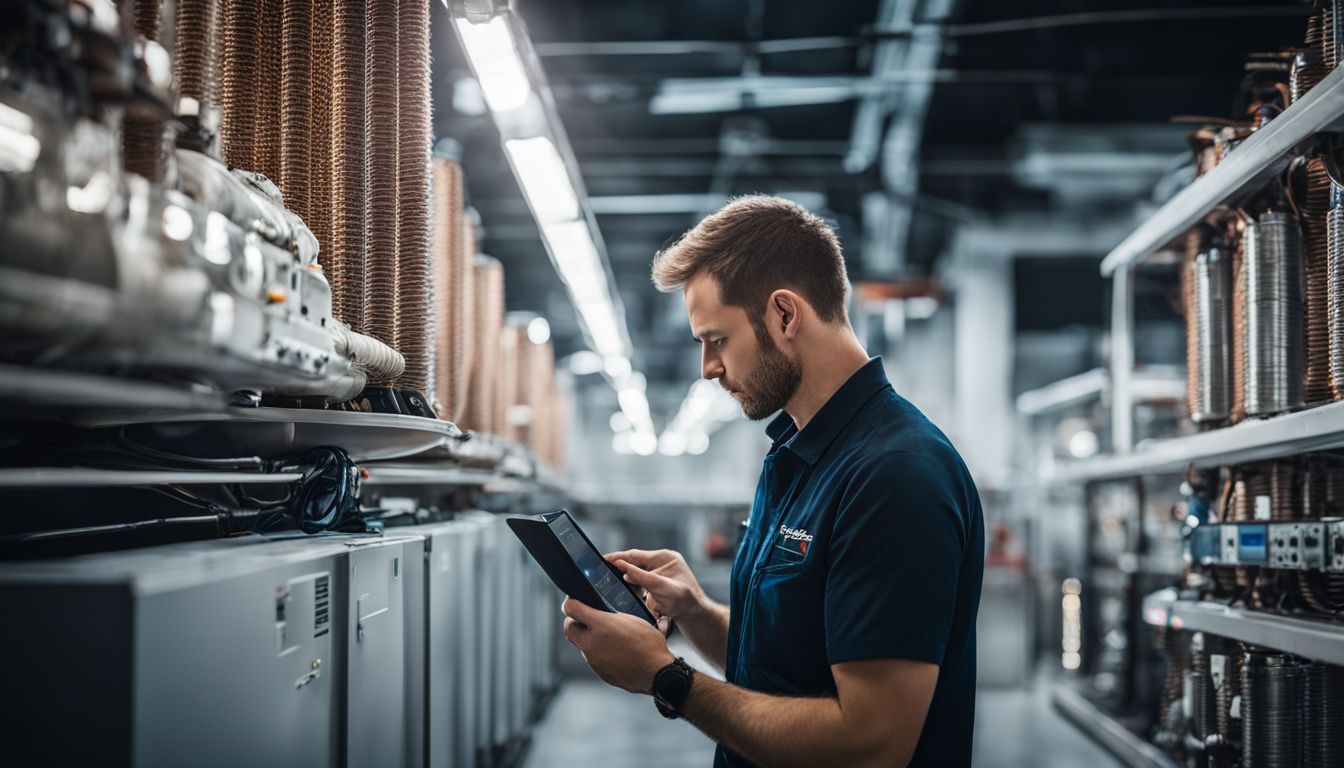
Next comes a key step in the HVAC process. This gas then travels outside to dump all its captured warmth. It’s crucial for this exchange to happen efficiently so your rooms stay pleasantly cool without wasting energy.
Compression of Vaporised Refrigerant

As the refrigerant leaves the indoor coils, it heads to the compressor. Here, it’s squeezed tightly to increase temperature and pressure. This step is super important for air conditioners to work properly.
The compressor acts like a pump for the refrigerant gas. It pushes the heated, high-pressure gas towards the condenser coils. There, it will get ready to dump its heat outside.
Heat Loss in the Condenser Coils

Heat moves out of the refrigerant in the condenser coils. The outdoor fan helps by blowing air across these coils. This process is core to cooling down your aircon. It makes sure that heat doesn’t stay inside.
The refrigerant loses heat and turns back into a liquid here. This change is vital for keeping your home cool. Without this step, the AC can’t suck up new heat from your house’s air.
Cooling would then stop working well, and energy use might go up too much.
Cooling of Warm Refrigerant
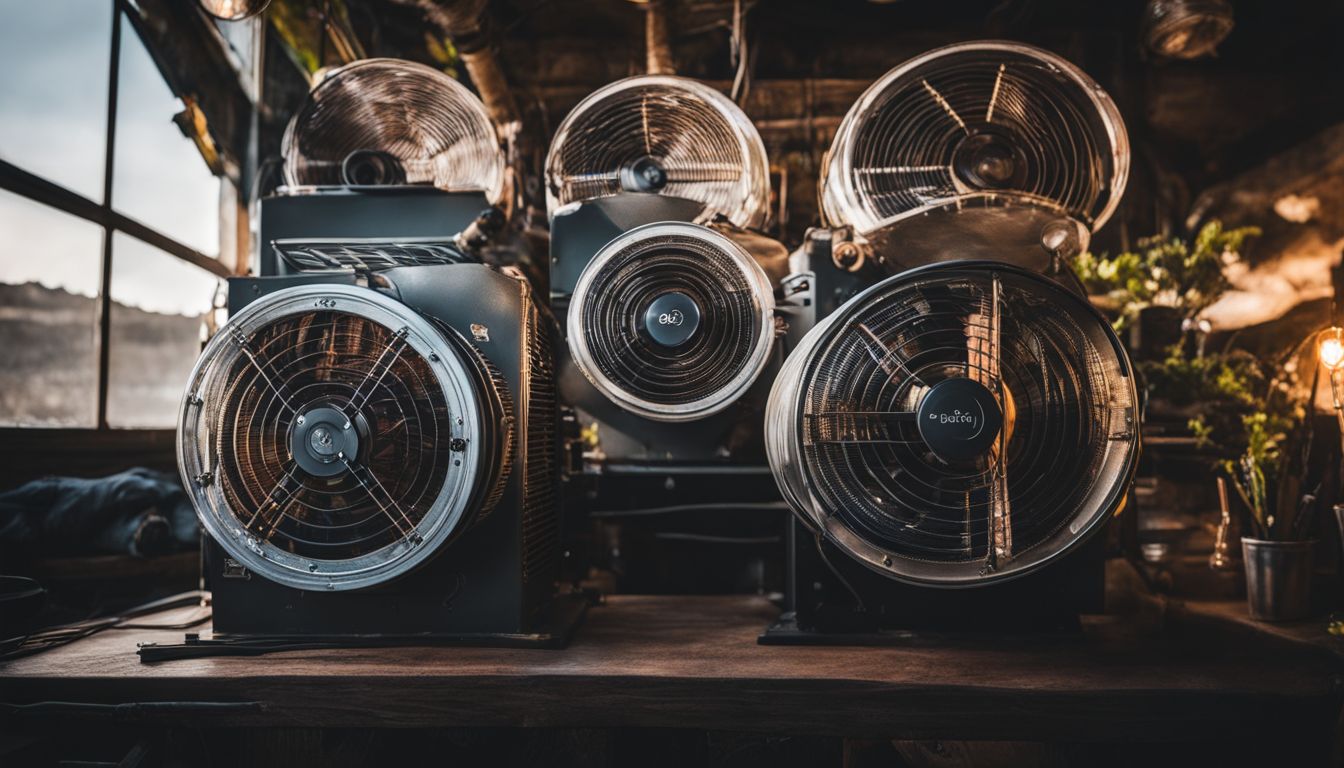
The warm refrigerant is cooled down through the condenser coils. Outside air blows over these coils, taking away the heat. This process changes the refrigerant from a hot gas to a cooler liquid.
The expansion valve then plays its part. It slows down the liquid refrigerant, which causes it to drop in temperature and pressure before entering the evaporator coil.
Inside the evaporator coil, another important phase begins. The coolant absorbs warmth from indoor air and turns back into a gas. This cycle repeats to keep rooms cool and comfortable.
Next up, we’ll look into factors affecting your choice of aircon gas.
Factors to Deliberate When Choosing Aircon Gas for Your System

Choosing the right aircon gas requires looking at your system’s type and cooling needs. Think about how powerful your air conditioner is. More power might need a different kind of refrigerant to work well.
You also want to pick a gas that does less harm to our planet. Gases like R-410A are better because they don’t hurt the ozone layer as much.
Look for gases with high energy efficiency too. This means they cool your home using less electricity, which saves you money on bills. R-32 is a good option for its great efficiency and lower impact on global warming.
Always talk to an expert HVAC person before making a choice. They know what works best with your specific aircon unit and can guide you right.
Environmental rules are important too when picking out aircon gas. Some gases are not okay anymore because they are bad for the environment, like R-22. Instead, go for ones that meet new regulations so you won’t have trouble later on.
Understanding How Air Conditioning Works in Vehicles

Delve into the intricacies of your car’s cooling sanctuary as we explore how air conditioning systems maintain a crisp, refreshing atmosphere on those sweltering drives. Witness the silent dance of refrigerants that keep you cool behind the wheel, an engineering marvel often taken for granted.
Role of Refrigerant in Vehicle’s Air Conditioning
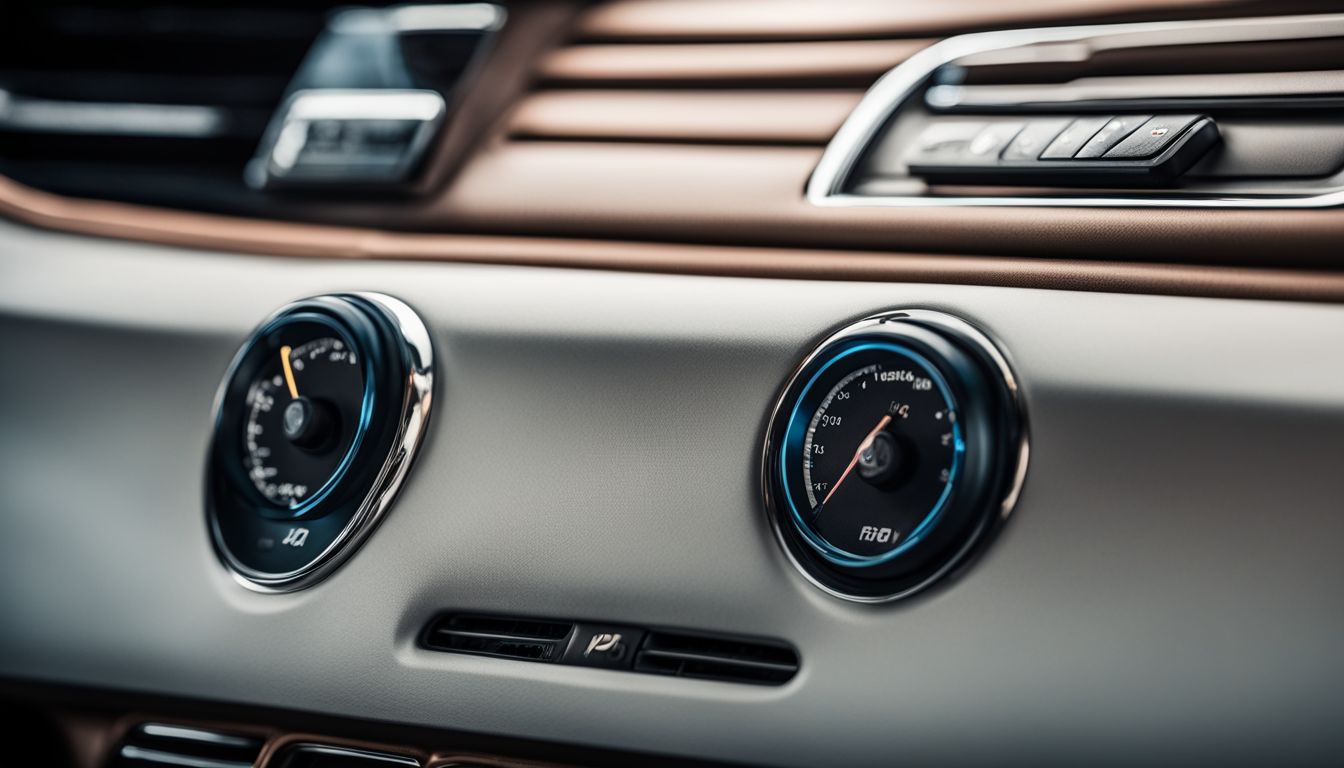
Refrigerant in a vehicle’s air conditioning system plays a crucial part. It absorbs heat from inside the car, making the air cool and comfortable. This substance changes between liquid and gas to move heat out of the vehicle.
The refrigerant starts as a low-pressure gas before the compressor turns it into high-pressure gas.
Next, it moves to the condenser where it loses heat and becomes a cooler liquid. This cold refrigerant passes through an expansion valve, dropping in pressure again. As it reaches the evaporator, it takes in heat from the car’s cabin and turns back into gas.
This cycle keeps repeating to keep you cool on hot days.
Cycle of Evaporation and Condensation in Vehicle’s AC
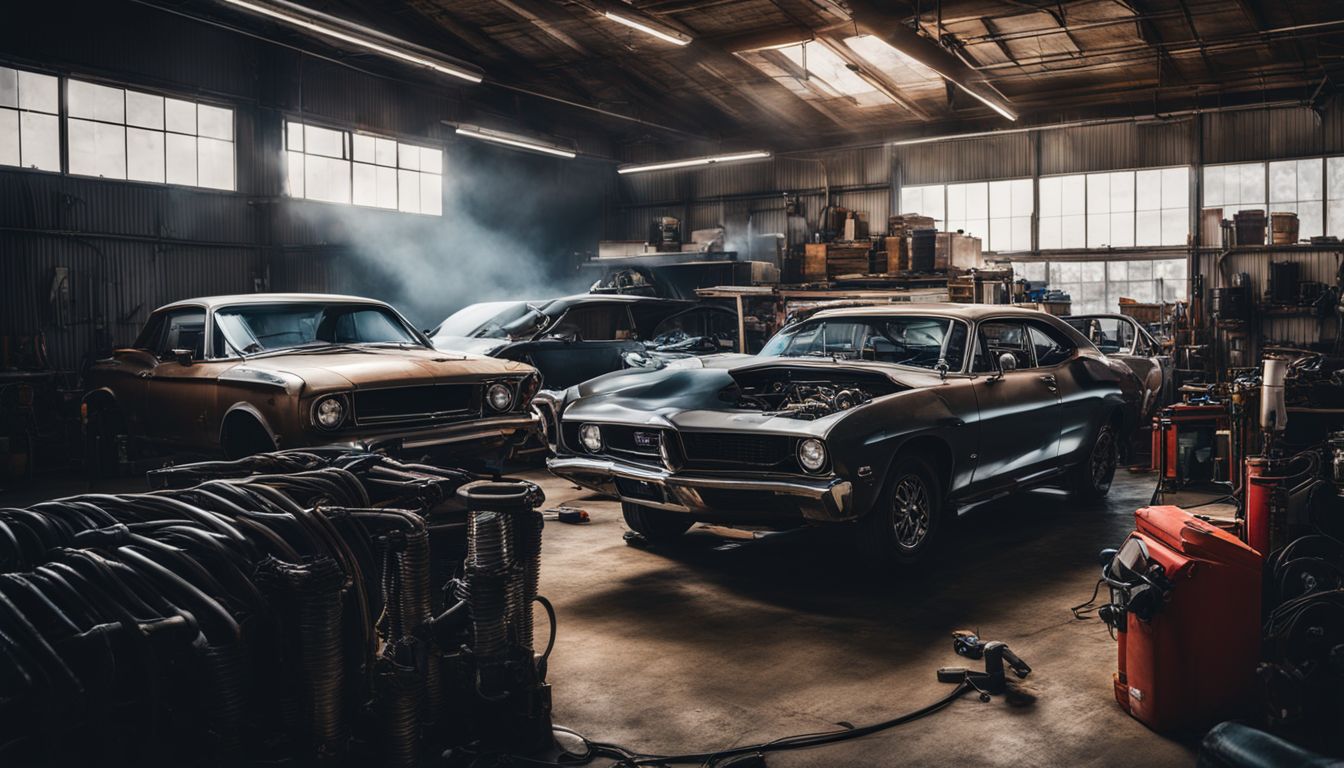
- The refrigerant starts off as a low – pressure gas in the evaporator.
- Inside the evaporator, it absorbs heat from the car’s cabin air.
- This absorbed heat causes the refrigerant to change from a liquid to a vapour, cooling the air inside.
- Next, the compressor squeezes this vapour, raising its pressure and temperature significantly.
- The heated vapour moves to the condenser coils located at the front of your car.
- As outside air flows through these coils, it removes heat from the refrigerant.
- This cooling causes the hot vapour to turn back into a liquid form.
- Now as a high – pressure liquid, it flows through an expansion valve.
- Passing through this valve makes its pressure and temperature drop sharply.
- It returns to being a low – pressure liquid as it enters back into the evaporator coils.
The Role of Compressor in Air Conditioning
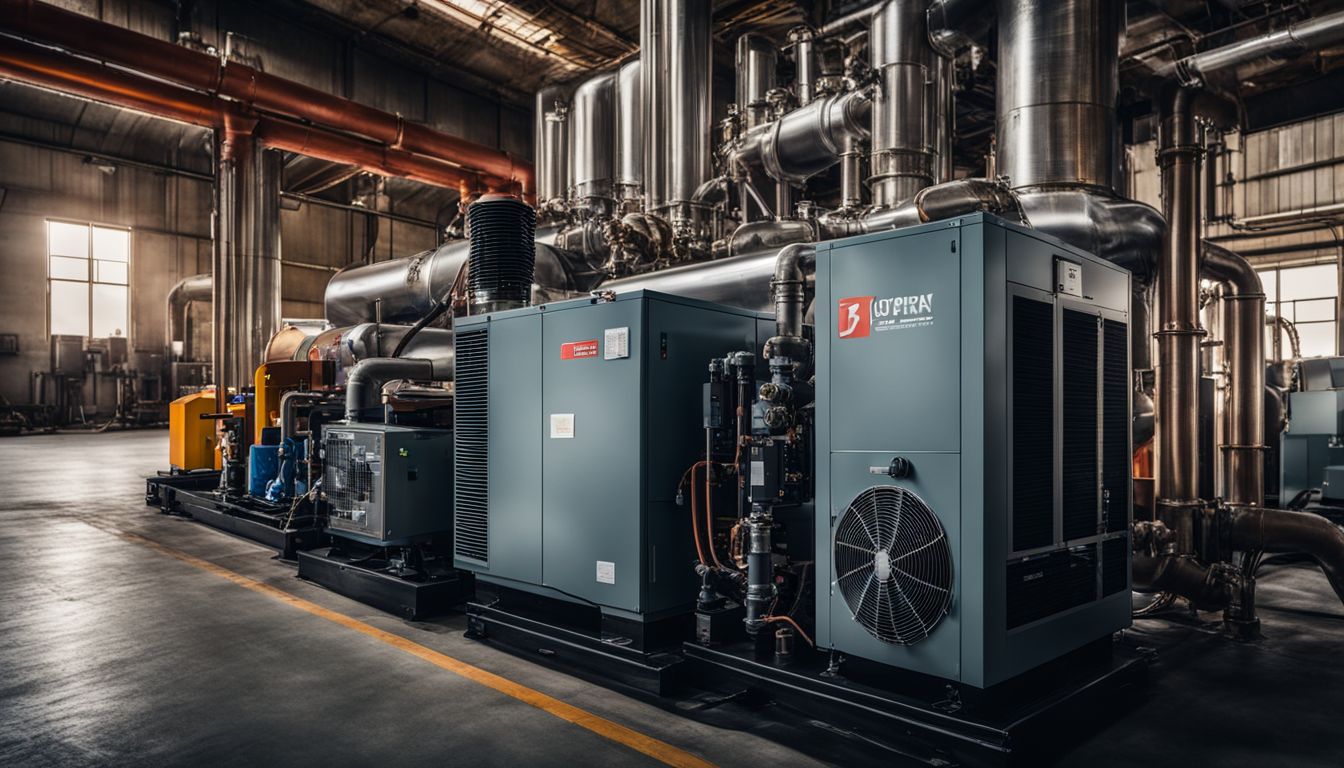
The compressor stands at the heart of any air conditioning system, tirelessly pumping refrigerant through the unit to maintain a cool and comfortable environment. It is this vital component that enables the transition of refrigerant from a low-pressure gas to a high-pressure state, driving the entire cooling process forward.
Compression of Refrigerant Vapour
Refrigerant vapour gets squeezed in the compressor. This action heats up and raises its pressure. High-pressure gas is vital for moving heat outside in air conditioning systems.
This part of the process transforms a low-pressure vapour into something much stronger and hotter. It’s like pumping up a bike tyre but with gas instead of air. Once compressed, this refrigerant is ready to release its heat in the next stage.
Movement of Compressed Gas to the Condenser
After the refrigerant vapour gets compressed, it’s time for it to move along in the cycle. The compressor does a great job here by pressurising this gas. This process heats up the refrigerant, making it both hot and high-pressure.
It’s now ready to travel to the condenser.
The condenser stands waiting to cool down this heated gas. Here, something amazing happens: the hot gas changes into a liquid form! While doing so, it releases its heat into the air outside.
Fans help with this by blowing air over the condenser coils. As a result, heat moves from the refrigerant to the outdoors quickly. This step is vital because it gets rid of unwanted warmth before sending the refrigerant back inside again.
The Function of Condenser in Air Conditioning

In air conditioning systems, the condenser plays a crucial role by expelling heat absorbed from the indoor environment to the outdoors. It is here that the hot refrigerant gas releases its thermal energy, facilitated by an outdoor fan, transitioning back to a liquid state ready for another cooling cycle.
Reception of Hot Gas from Compressor
The compressor sends hot gas to the condenser. This step matters a lot for your air conditioner’s cooling power. It must handle this hot gas right, or it won’t cool well and could use too much energy.
The system needs to get the temperature of the gas down fast for everything to work well.
Fans in the unit blow over the coils carrying this hot gas from the compressor. This helps throw out the heat into outside air. By doing so, your room stays cool and comfy. If there’s a problem with getting rid of this heat, your AC might not do its job right.
Role of Outdoor Fan in Condenser Coil
An outdoor fan plays a key role in an air conditioning system’s condenser coil. It moves air across the coil to help release heat from the refrigerant inside. This keeps temperatures and pressures at safe levels.
Without this fan, the system could overheat, use too much energy or even get damaged.
For your air conditioner to work well, the fan must be clean and in good shape. If it breaks, you might notice problems like poor cooling. To keep everything running smoothly, check and tidy up your outdoor fan regularly.
Now let’s explore how an evaporator fits into all of this.
The Working of Evaporator in Air Conditioning
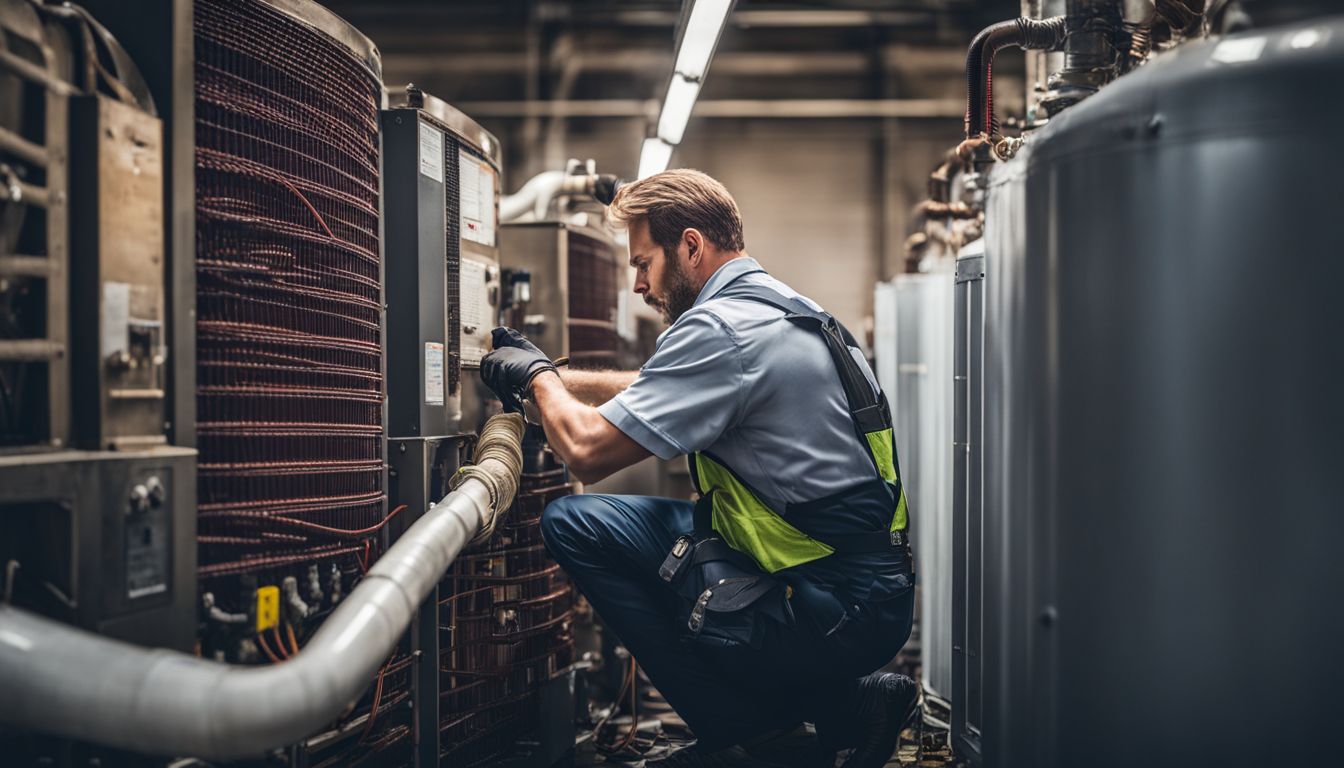
In the heart of your air conditioning unit, the evaporator plays a critical role where it receives chilled refrigerant ready to absorb heat from within the room. As warm air meets the cold coils, moisture condenses and heat is extracted, resulting in cooler temperatures being circulated back into your space.
Reception of Refrigerant in Evaporator
Cool air fills your room because of what happens inside the evaporator. The refrigerant arrives as a cold liquid. It’s ready to soak up all the warmth from your home. Inside the coils, it does an amazing trick.
It changes from a cool liquid into a warmer gas. This switch happens because it grabs heat from the air blown over by the fan.
The evaporator works under tight control, keeping things just right for this process. Special valves and sensors watch every change in temperature and pressure. This careful balance lets your air conditioner make sure your house stays cool and comfy.
Role of Room’s Warm Air in Evaporator Coil
Warm air in the room plays a vital part in the air conditioning process. It blows over the evaporator coil, where something special happens. The refrigerant inside this coil is ready to absorb all that heat.
As it does, it turns from a cool liquid into a warmer gas.
This magic trick doesn’t just happen; it’s essential for keeping everyone comfortable indoors. The warm air loses its heat to the refrigerant and becomes cool air once more. Then, fans push this newly chilled air back out into the room.
This cycle keeps repeating, making hot days feel like a breeze inside!
Unusual Smell from AC Unit
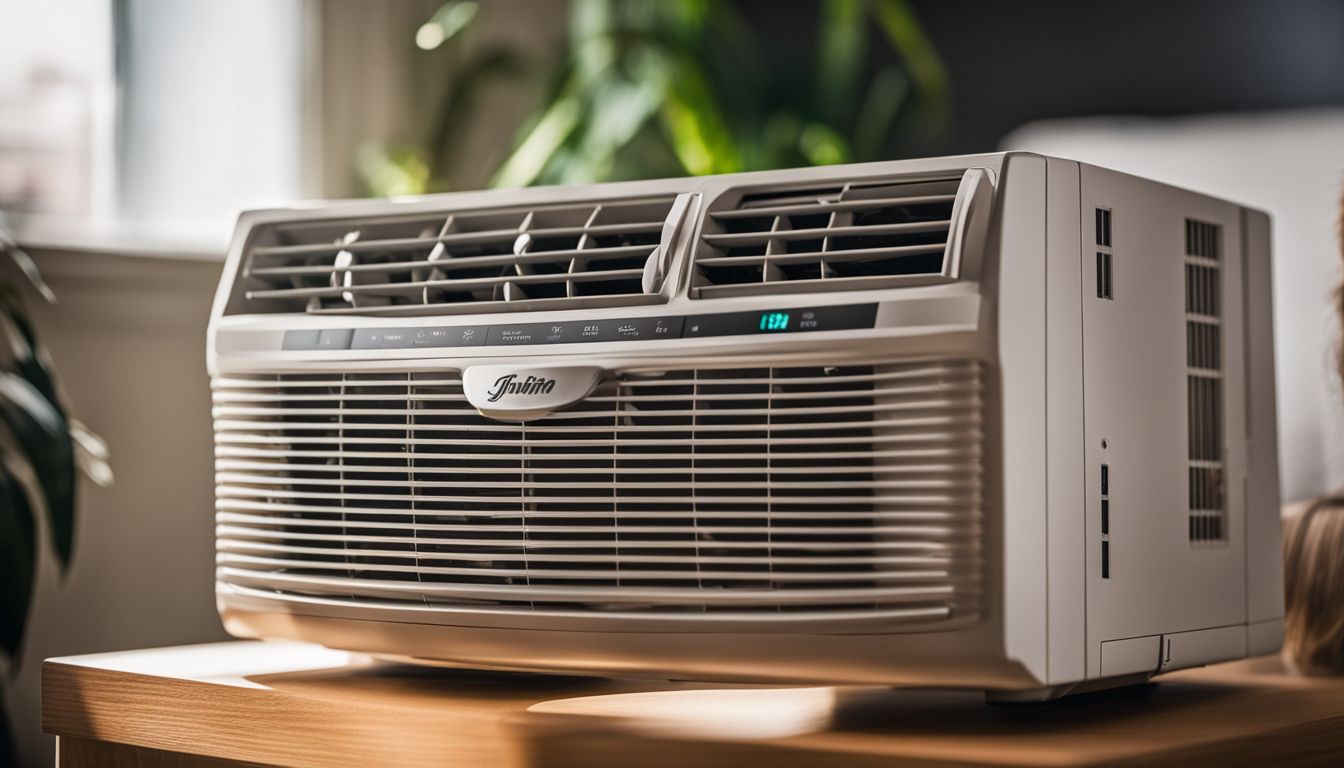
Diving into the sensory realm of air conditioning, a peculiar odour emanating from your AC unit may signal underlying issues that demand attention. It’s paramount to identify and address these scents promptly to ensure the integrity and functionality of your cooling system.
Possible Causes of Gas-Like Smell
Air conditioners sometimes make a room smell like gas. This is not normal and might mean there’s a problem with your AC.
- A refrigerant leak could be the reason for the smell. The gas from the aircon has a sweet, sharp odour. If you notice this smell, it often means that the coolant, which helps cool your home, is escaping from the system.
- Gas leaks are dangerous and need quick action. When your AC smells like gas, it might be an actual gas leak and not from the refrigerant. This is serious and you should leave your home and call for help right away.
- Foul odours can come from mold or mildew inside your air conditioning unit. Damp, dark places make it easy for mold to grow. When air blows through, it can carry this bad smell into your room.
- Clogged drain lines can also cause stinky smells. Water that doesn’t drain correctly can lead to bacteria and mold growth.
- Dead animals such as rodents or birds sometimes get stuck in the ductwork of an AC unit and start to decompose. This causes a strong, unpleasant odour.
- Dirty air filters might give off a musty smell if they haven’t been changed in a while. Dust and other particles trapped in the filter can start to build up and rot.
- Overheating parts within the AC unit may emit a burning or gunpowder – like scent when they get too hot.
Significance of Unusual Smells
Unusual smells from an aircon unit are a warning sign. They often mean something is wrong inside the system. A bad odor can point to mold or bacteria buildup in the coils or ductwork.
This can harm both the unit’s efficiency and your health.
A gas-like smell could suggest a refrigerant leak. Leaks are serious and need quick fixing. If you smell something strange, act fast to get it checked out by a professional. Safe operation of your air conditioning relies on finding and solving these issues quickly.
Regular checks help avoid nasty odors and keep your conditioner working well.
Preventive Measures for Unpleasant AC Smells
Unpleasant odours from air conditioning units can be frustrating. Proper maintenance helps to keep the air fresh and clean.
- Clean or replace the air filter regularly to stop smells from building up. This simple step keeps dirt and debris from clogging the system.
- Schedule a professional HVAC technician to inspect and clean your unit. They can spot problems early and fix them fast.
- Use a dehumidifier in your home to lower moisture levels. Dry air means fewer smells from mildew or mould.
- Check for leaks in the AC system often. Fixing them quickly stops odours from spreading.
- Keep the area around your air conditioner free of rubbish. This prevents outside smells from entering your home through the AC unit.
Conclusion

Understanding how aircon gas works helps us keep our homes cool and comfortable. We’ve explored the refrigeration cycle and key components like compressors, condensers, and evaporators.
Recognising smells can alert us to issues within our systems. Regular checks ensure our air conditioners run safely and efficiently. Remember, professional advice is key for any concerns with your HVAC system.
FAQs
1. How does an air conditioning system cool my room?
An air conditioning system uses a refrigerant in a vapor-compression cycle to transfer heat from your room to the outside, making it cooler and more comfortable.
2. What are fan coil units and how do they work in HVAC systems?
Fan coil units are devices that use fans and coils to circulate cold or warm air in your home as part of HVAC (heating, ventilation, and air conditioning) systems.
3. Can you explain what a heat pump is?
A heat pump is part of an Hvac system that can either heat up or cool down your space by moving heat from one place to another using electricity.
4. What’s the difference between active cooling and passive cooling systems?
Active cooling uses devices like air conditioners to remove heat, while passive cooling relies on natural ways like wind-driven ventilation or daytime radiative cooling without machines.
5. Is using an absorption chiller for my business energy-efficient?
Yes! Absorption chillers can be energy-efficient because they take advantage of waste heat instead of relying solely on electricity, especially when combined with other eco-friendly technologies.
6. Why should I consider getting an Air Source Heat Pump (ASHP)?
An Air Source Heat Pump is good if you want a single device for both heating and cooling; these pumps are also often more energy-efficient than traditional methods.
